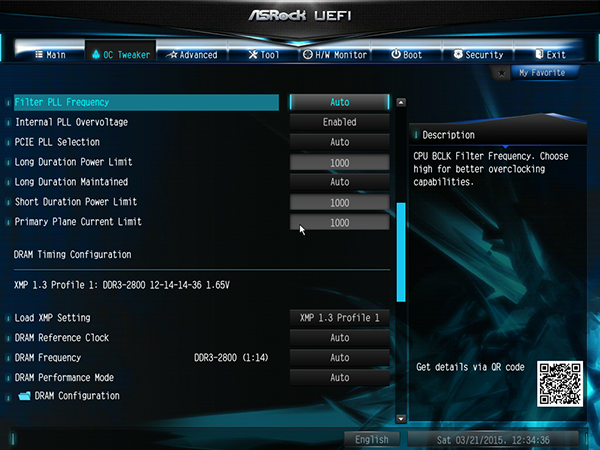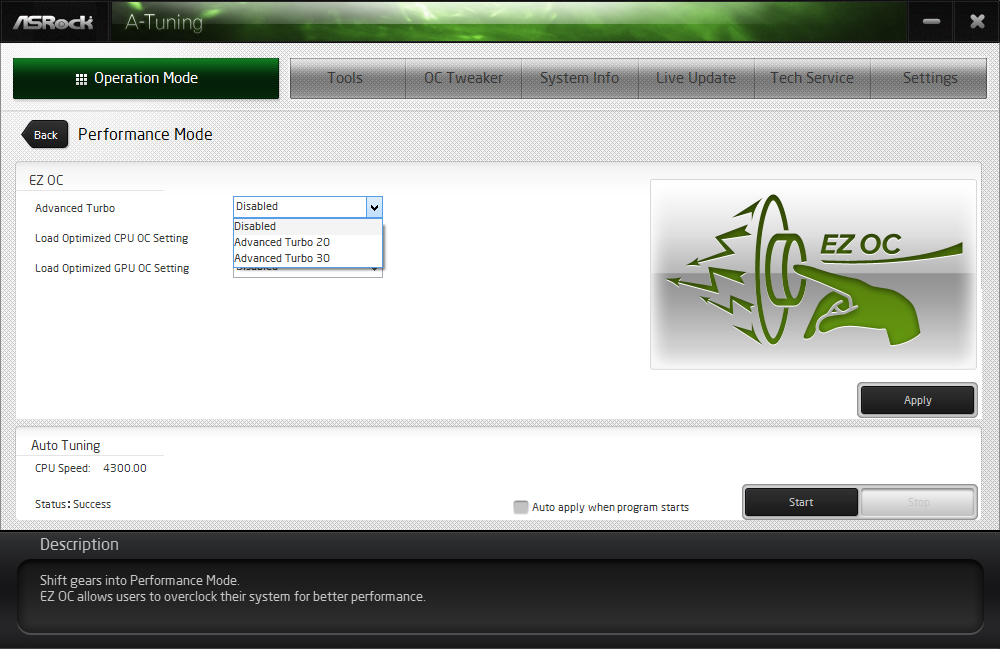ASRock Z97M-ITX/ac Versus MSI Z97I AC
Why you can trust Tom's Hardware
Z97M-ITX/ac Overclocking Software And Firmware
ASRock A-Tuning includes several “Power” modes (the “Power Saving” option saved us around 8W under full load), plus automatic, programmed and manual overclocking options.
Two factory-programmed overclocking types include “Advanced Turbo” and “Optimized CPU OC Setting”. Advanced Turbo is designed to provide a 20% or 30% performance boost. It pushed our CPU to 4.5 and 4.6GHz respectively. The motherboard voltage regulator unfortunately couldn’t keep up with the 1.27 and 1.36V CPU core settings, forcing the motherboard into a CPU-throttling overcurrent protection mode almost the instant a heavy software load was applied.
“Optmized CPU OC” settings are derived directly from those in firmware, again triggering the Z97M-ITX/ac’s overcurrent protection. Even the “Auto tuning” option, which is supposed to find the maximum stable setting, used a core voltage (1.2V) that resulted in power regulator thermal protection after several minutes. A heat sink on its transistors might have solved that issue.

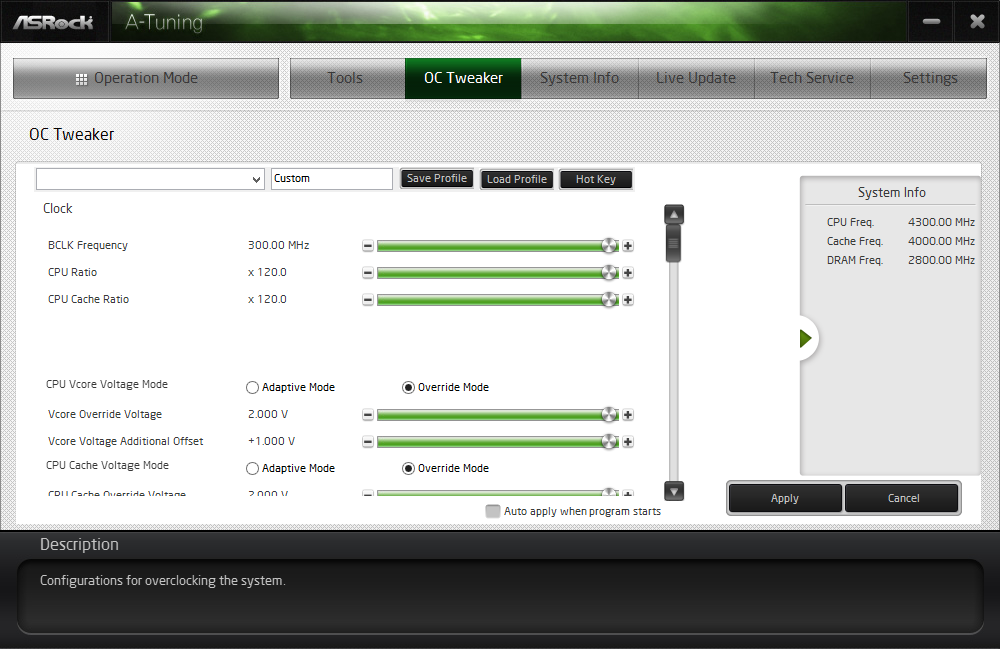

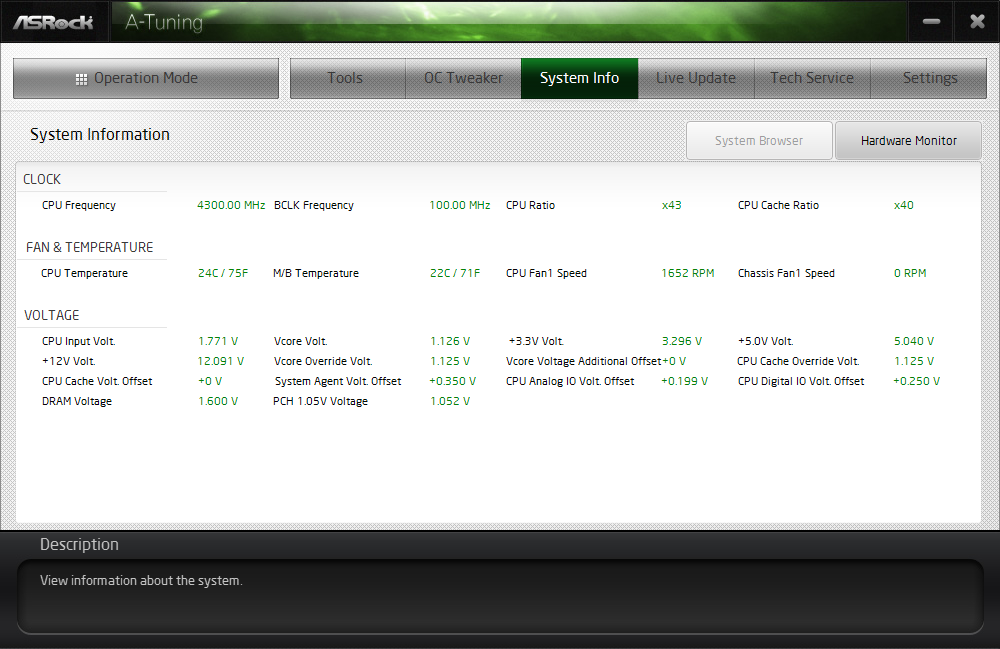




ASRock A-Tuning provides Windows-level access to the Z97M-ITX/ac’s full range of firmware-based frequency and voltage settings.
Additional A-tuning menus provide hardware monitoring, Web-based software update checks, a tech service mail application and an option to start the program with Windows.
ASRock’s “OC Tweaker” firmware menu starts with a group of basic overclocking settings that are supposed to make it easy for novices to get started. They also work great as a starting point for a maximum overclock stability test, since enabling one of these profiles also locks the CPU multiplier and adjusts any related power settings. That is, assuming you have an overclockable K-series processor to begin with.
“Optimized CPU OC Setting” options include 4.5GHz at 1.23V core, 4.6GHz at 1.28V and 4.7GHz at 1.4V. I have to wonder if these settings were developed on a different motherboard or CPU, though, since overcurrent protection for the Z79M-ITX/ac’s tiny voltage regulator tripped at nearly any level of CPU load. Overcurrent protection induces clock throttling, and you can’t honestly brag about 4.6GHz when the excess current load forces the motherboard to drop down to a frequency below that of the CPU’s stock clock.
Get Tom's Hardware's best news and in-depth reviews, straight to your inbox.
XMP works for these DDR3-2800 modules, and the setting even worked with a 101MHz BCLK, resulting in a 2827 MT/s data rate.


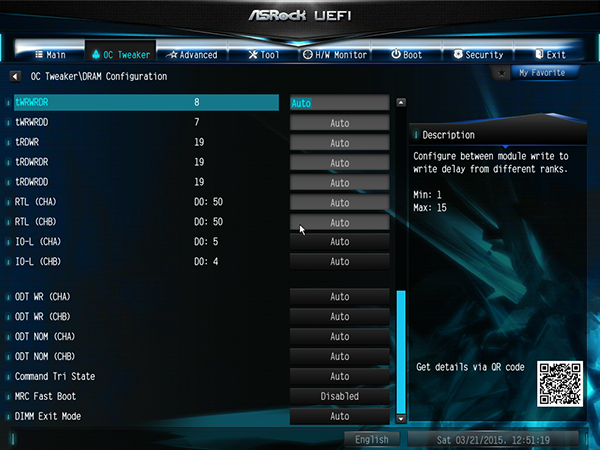
Our typical 1.28V overclock setting would have pushed the CPU to its thermal limit at 4.6GHz, but the Z97M-ITX/ac wasn’t so cooperative. Even the Core i7-4790K’s default voltage is too high for this motherboard to maintain a fixed-ratio 4.4GHz frequency with all four cores loaded, though the default Turbo Boost ratio for four-core loads is only 42x.
Instead, we were forced to undervolt in order to overclock at a fixed frequency and full load. That lower voltage limited the CPU's stability to 4.3 GHz. Still, 43x is greater than 42x. So apart from those expecting to use “Enhanced” Turbo Boost ratios, where the maximum multiplier is applied regardless of the number of cores loaded, we’d call this a win.
The Z97M-ITX/ac welcomes memory tweakers with a full selection of primary, secondary and tertiary timings.
Current page: Z97M-ITX/ac Overclocking Software And Firmware
Prev Page ASRock Z97M-ITX/ac Next Page MSI Z97I AC-
i7Baby 4K on integrated graphics?Reply
I think I'd prefer to use a very heavy graphics card.
Would it be a better deal to get a mitx mobo and add a pcie wifi card yourself? -
Luay Well, the reason WI-FI on mitx doesn't matter is because a simple USB WI-FI dongle will do the trick. Arguably, sound chips don't matter either becasue a USB headsets, or even better, HDMI from the video card through an AV receiver will also free up a motherboard's budget for the more important features we want.Reply
What's unforgivable in those two models is the lack of an M.2 slot. -
i7Baby Dongles don't work as well as pcie wifi cards mainly because dongles don't have good antennae.Reply
I don't think M.2 is worth it yet. The SSDs aren't any faster than sata SSDs - so far any way. -
Crashman Reply
Don't worry about 4k, think about QHD (2560x1440), particularly in work environments such as displaying large spreadsheets. People say the previous-generation HDMI and single-link DVI is limited to 1080p, but I think that's because they forget about the 1920x1200 option.15721416 said:4K on integrated graphics?
I think I'd prefer to use a very heavy graphics card.
Would it be a better deal to get a mitx mobo and add a pcie wifi card yourself?
The problem is that the ASRock board doesn't allow ANY resolution above 1920x1200, including the ever-present QHD.
The solution is that the MSI board allows EVERY resolution up to 4k, including the ever-present QHD.
I hope when I phrase it like that, you'll understand why 4k isn't the issue: It's the "up to 4k" part--those in-between settings like 2560x1440--that matter enough in typical integrated graphics markets to make this an important feature. -
dvanburen This Asrock board doesn't make a sensible purchase. Asrock offers a much nicer version (Z97E-ITX/ac) with a 6-phase power controller, Display Port, Intel LAN, VRM Heatsink, better audio and more. It's usually about $117 AR in the US, only a $15 premium over the reviewed Z97M-ITX/ac.Reply
Asrock also offers the H97M-ITX/ac, which is virtually identical to the reviewed Z97M-ITX/ac other than the chipset. Seriously, it's the same PCB. It's also $19 less expensive. I doubt that anyone is going to buy the Z97M-ITX/ac to overclock, so what's the point of choosing Z97 over H97? Oh, the H97M-ITX/ac can overclock too. So again, why does the Z97M-ITX/ac even exist?
TL,DR: Save your money and get the H97M-ITX/ac if you want a decent HTPC/NAS/Whatever. Buy the Z97E-ITX/ac if you want more features and better OC potential. Skip the Z97M-ITX/ac. -
logainofhades I wonder why Asrock sent there inferior board? Maybe someone at Asrock goofed. The Z97E-ITX/ac is definitely a far better board and includes an M.2 slot. Also the other companies that declined to offer a review sample, makes me feel they didn't see their product as good enough to compete. I shall avoid their ITX boards, in the future.Reply -
Onus Perhaps other mITX offerings will make an appearance soon...Reply
(If you don't care about overclocking, the H97M-ITXa/c is indeed a nice board)
Reviews are sometimes centered around a particular price point, which may be why the more premium products aren't shown here.
I just built Minion using a Maximus VII Impact. The only thing I wish it had, and this is minor, is a second USB2.0 header so I can use an existing card reader with it. I'll just buy an external USB3.0 card reader instead. -
logainofhades Their price is similar enough, that I don't see the point of the Z97 board we were given, vs the one we really wanted to see.Reply
PCPartPicker part list / Price breakdown by merchant
Motherboard: MSI Z97I AC Mini ITX LGA1150 Motherboard ($122.99 @ SuperBiiz)
Total: $122.99
Prices include shipping, taxes, and discounts when availableGenerated by PCPartPicker 2015-04-21 16:27 EDT-0400
PCPartPicker part list / Price breakdown by merchant
Motherboard: ASRock Z97E-ITX/ac Mini ITX LGA1150 Motherboard ($129.99 @ SuperBiiz)
Total: $129.99
Prices include shipping, taxes, and discounts when availableGenerated by PCPartPicker 2015-04-21 16:27 EDT-0400
PCPartPicker part list / Price breakdown by merchant
Motherboard: ASRock Z97M-ITX/AC Mini ITX LGA1150 Motherboard ($117.99 @ SuperBiiz)
Total: $117.99
Prices include shipping, taxes, and discounts when availableGenerated by PCPartPicker 2015-04-21 16:28 EDT-0400

